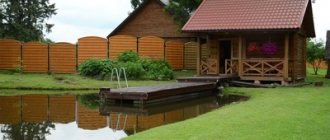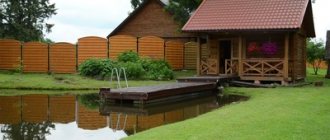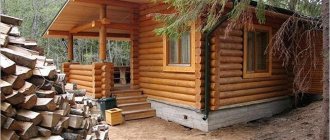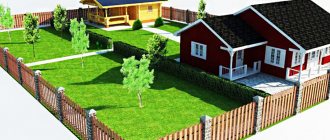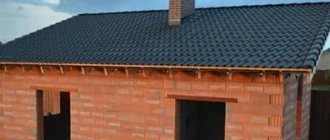Each owner of his own plot eventually asks questions about its improvement. In addition to the cottage, country house or other residential structure, outbuildings or other buildings are being erected. Often, owners build a bathhouse on their backyard or summer cottage. In the process of planning the construction of such a facility, it is important to consider the requirements of current legislation. The article contains the main provisions concerning the issue of building a bathhouse on your own site in 2021.
To register or not to register?
In Russia today, legislation simultaneously affects several branches of law, answering the question of whether it is necessary to register a bathhouse. It is important to take into account the requirements of housing, civil, tax, and land legislation relevant in 2021. In accordance with Art. 131 of the Civil Code of the Russian Federation, real estate requires mandatory state registration . But it is also worth considering that the bathhouse can be considered as:
- Temporary building. In this case, registration is not required.
- Real estate. Registration is required.
The difficulty is that it is difficult to determine what signs a bathhouse has. According to Art. 130 of the Civil Code of the Russian Federation, there are 2 main characteristics of real estate:
- Inextricably linked to the earth.
- Cannot be separated from the soil without causing great damage.
In other words, if the building is not temporary, it has a foundation, communications are connected, there are strong supporting structures, registration is required. In most cases, a bathhouse on the site must be registered.
Do I need to receive it?
In accordance with Part 6 of Art. 1 Federal Law No. 218 of July 13, 2019 “On state registration of real estate” and Art. 130 of the Civil Code of the Russian Federation, bathhouses with a foundation belong to the category of capital buildings and require registration. In this case, a construction permit and project approval are required.
A construction notice is submitted in the following cases:
- the bathhouse is planned as an extension to the cottage;
- the bathhouse includes a relaxation room with a sleeping place;
- a bathhouse complex for commercial use is planned.
In the latter case, it is necessary to obtain a full permit for the construction of the facility.
Additionally, a project is being prepared; permission from neighbors is required. Coordination with such authorities as SES and Rosnedra is necessary.
As a separate building
A compact, lightweight building with a non-buried foundation does not require permission .
At the same time, communications should not be connected to it. A bathhouse without a permanent foundation can be installed on a SNT, individual housing construction or private plot plot. A permit will be required if the building has a permanent foundation and communications are connected to it - water supply, sewerage, electricity.
This category includes two-story buildings and options with an attic , where a recreation room with a sleeping place is provided.
If you plan to build a commercial bathhouse, you will need additional permission from the fire inspectorate and sanitary and epidemiological station. Only after this can you conduct business legally.
As an extension to a residential building
If the house was built previously, a permit will be required. It is necessary to submit a new building project for consideration to the administration.
In this case, the following parameters are taken into account:
- increase in area;
- compliance with fire and sanitary requirements;
- maintaining the safety margin of the walls and foundation.
This requirement applies equally to personal use and to a commercial bathhouse. In the latter case, the conclusions of the SES and fire inspector are required.
New registration rules
On March 1, 2021, new property registration rules enshrined in Law No. 340-FZ came into force. Capital construction can be legalized only after the construction (planned or completed) has been approved by the local administration. If construction work has not been completed by March 1, 2021, it is mandatory to notify local authorities.
Permits will have to be obtained if the bathhouse is combined with a cottage or other residential building. If it is planned to build a commercial bathhouse on the site, its registration is also mandatory.
Fines for unauthorized construction 2021
The Code of Administrative Offenses of the Russian Federation established monetary penalties for the construction of real estate without permits
- For citizens from 2,000 to 5,000 rubles
- For officials from 20,000 to 50,000 rubles
- For legal entities from 500,000 to 1,000,000 rubles
When registering unauthorized construction, penalties cannot be avoided; they will have to be paid in any case, but the consequences may be more global. The further development of events is the liquidation of real estate. In order to avoid such consequences, as well as for the purposes of the legitimate use and operation of the property, we strongly recommend that you consider the issue of legalizing unauthorized construction.
On what site is it allowed to build a bathhouse?
You can plan the construction of a bathhouse on the following types of sites:
- Land in cities of various sizes, villages, villages, intended for individual housing construction.
- Privately owned plots on which there is a subsidiary plot, used for personal agricultural work.
- From January 1, 2021, dacha lands will be abolished. Therefore, according to Law No. 217-FZ of July 29, 2017, permanent buildings can be erected on garden lands, and only utility and temporary buildings on garden lands.
A project is being prepared for future development. After its consideration, a decision is made on the need for registration. Only after receiving the appropriate documentation will the owner be able to legally perform the necessary actions with real estate (sale, donation, inheritance, etc.).
Cost and terms
The price for paperwork depends on the region of residence . The main costs consist of preparing a technical plan. In the Moscow region the cost reaches 15,000-18,000 rubles. In other regions it is about 8,000 rubles.
It is also necessary to pay a state registration fee of 350 rubles for a bathhouse without a permit or 2,000 rubles for a capital building.
The notice in the architecture department is considered within 7 days. The answer arrives by mail within a week on average. After completion of construction, the owner has 1 month to send a second notice. It is also reviewed within 7 days.
On average, it takes 2-3 weeks to prepare a technical plan from the date of application. As a result, about a month passes from the moment of application, if you do not make mistakes in the documents.
Basic construction requirements
When planning and constructing a bathhouse, you must be guided by construction, sanitary standards, and fire safety regulations . Otherwise, operation of the facility will be unsafe. The basic rules are specified in SNiP 30-02-97 with amendments relevant in 2021. The bathhouse must meet the following requirements:
- Located at a distance of at least 1 m from the neighbors' property.
- The object is located at least 15 m away from wooden buildings (including buildings and structures of neighbors).
- The bathhouse is located at least 8 m from the residential building.
- A distance of at least 15 m should be maintained to the forest area. There should be a distance of at least 4 m to tall trees on the site, and at least 1 m to shrubs.
- The bathhouse is located at a distance of 22 m or more from the reservoir.
- The structure is erected from a well or borehole at a distance of 12 m. The drainage can be organized into a septic tank. The autonomous sewer system is located at least 1.5 m away from the neighboring plot.
- The building is located at a distance of at least 5 m from the red line. The building must be at a distance of 6 m from the roadway.
It is advisable to choose an elevated area for building a bathhouse. This will prevent flooding of the structure. In the process of preparing a construction plan, the location of communications on the site is taken into account. There should be no electricity, gas, water supply or other engineering systems running under the bathhouse.
What fire, sanitary and construction safety standards must be observed?
It is important to comply with current regulations so as not to encounter a construction ban or a dangerous situation during the operation of the bathhouse.
During construction, you must be guided by the following construction and sanitary standards:
The distance from the bathhouse to the neighboring area is at least 2.5 meters.- It is necessary to retreat 5 meters from residential buildings.
- The distance of the object from the road is at least 6 meters.
- The distance to the nearest body of water is at least 22 meters. This requirement also applies to hydraulic structures such as a well or a well.
- It is not allowed to build a bathhouse on a site that is subject to regular flooding.
- It is important to properly organize the drainage. It is possible to purchase a full-fledged treatment system or install a septic tank of sufficient capacity. A distance of 1.5 meters is maintained from the sewage system to the fence with neighbors.
When choosing a place to build a bathhouse, the wind rose is taken into account. This measure will protect the residential building and neighboring areas from smoke.
It is necessary to ensure compliance with fire safety. A traditional bathhouse is an object of increased danger. This is due to the storage of a large supply of fuel, the use of heating with an open firebox, and flammable materials as internal lining.
It is necessary to adhere to fire safety rules:
- wooden surfaces must be treated with a fire retardant;
- wood with a low rate of resin separation is used;
- the ceiling and chimney are insulated with heat-resistant material;
- the walls and floor adjacent to the sauna stove are lined with protective screens made of non-combustible materials;
- Reliable ventilation and a fire extinguisher are necessary;
- The heat-generating elements of the furnace are raised 12 cm from the floor level.
During construction, the main attention is paid to the installation of electrical wiring. The main condition is the presence of grounding of devices that will be used on an ongoing basis.
Fire safety requirements
There is heating equipment in the bathhouse, so when constructing and arranging the facility, it is important to strictly comply with fire safety requirements. To avoid fire, property damage, harm to health or a threat to human life, it is important to consider the following:
- All wooden structural elements are treated with a fire retardant before assembly. Resinous wood species are not used in the steam room. Otherwise, when heated, the natural material will release resin on heated surfaces. If it comes into contact with the skin, it leaves serious burns.
- The ceiling and the stove smoke exhaust pipe are insulated with non-combustible materials.
- The floor and walls adjacent to the stove are lined with protective heat-resistant screens. A metal sheet with dimensions 650x750 mm is installed in front of the firebox.
- Elements that generate heat in the stove must be at least 120 mm from the floor.
- The bathhouse must have natural or forced ventilation.
- There must be a fire extinguisher in the building.
- The wiring is installed openly in special closed boxes. All electrical appliances are grounded. The wires have special self-extinguishing insulation.
Documents that regulate construction
For gardening non-profit partnerships (SNT), the standards for the construction of a bathhouse on a summer cottage are regulated by SP 53.13330.2011 and SNiP 30-02-97 (updated by additions from 2021).
Issues related to the registration of structures are addressed in the following codes:
- Tax;
- Civil;
- Housing
Issues of real estate registration (in some cases, baths fall under this category) are regulated by Federal Law No. 340.
Registration procedure
Regardless of the location of the bathhouse (in a populated area or SNT), the owner must perform a number of sequential actions:
- Before starting construction and installation work, send a notification to local authorities. The document indicates the plan and design features of the bathhouse. Attached are extracts from the Unified State Register of Real Estate and a technical plan. It is also important to prove ownership of the land (relevant documents are attached). You can contact local authorities in person, send documents by registered mail or using the MFC.
- Authorized persons check the compliance (non-compliance) of the planned facility with urban planning standards. The possibility of carrying out construction work on the specified site is also determined. If within 7-10 days the local government authorities do not respond to the appeal, the submitted plan is regarded as complying with the established standards. It can be used to build a bathhouse for 10 years.
- After completion of construction, no later than a month later, a second notification letter is sent to the local administration. Attached to it is a receipt confirming that the state duty has been paid. This is necessary for registering the property. The first notice and the documents sent along with it are also attached.
- The submitted documents are re-checked. The local administration sends information to Rosreestr to register ownership of the house.
If the owner of the site wants to speed up the registration process, you can send the relevant documents to Rosreestr after completion of construction yourself.
It is worth considering that the grounds for refusal may be a violation of building codes and regulations, or the lack of attached relevant documentation in circulation. In this case, the construction can only be legitimized in court.
Steam room as an extension to the house - how to design it
If access to the steam room is through a residential building, then it is considered an integral part of it. It is necessary to submit a notice of reconstruction to the administration and draw up a technical plan. Further, all actions are no different from registering a detached building.
Is it possible to register a bathhouse as a house? It is possible if the premises are converted into a residential category. To do this, there must be an owner, and the building must meet all the requirements for buildings suitable for habitation. This practice is not so common, and bath attendants prefer to separate housing and sauna. Read about how to decorate a bathhouse in the best traditions in the blog.
Package of documents
To register a bathhouse on your own site, you will need to collect a package of documents. It includes:
- Application of the established form indicating the address where the building will be located.
- Documents certifying ownership of the plot (extract from the Unified State Register of Real Estate, certificate of title, contract).
- Passport of the owner (representative of the owner and power of attorney) or other identification document.
- Boundary plan of the land plot.
- Construction permit.
- Project documentation. The document specifies the necessary technical information (dimensions, number of premises, building materials, heating equipment and other categories of construction).
- List, location of utilities that are suitable for the building. Scheme, type, location of wastewater disposal systems, drainage system.
- Receipts for payment of state fees.
What objects are considered unauthorized construction?
An unauthorized construction in 2021 is considered to be one that:
- Built on a plot of land that was not provided in accordance with the established procedure. The land must be owned or disposed of by persons on the basis of other title documents (lease agreement, purchase and sale agreement, agreement of perpetual use, right of lifelong inheritable possession).
- Built on land on which the construction of a specific type of object is prohibited, i.e. does not allow the type of permitted use.
- Built without obtaining approvals and (or) construction permits from local authorities.
- Has violations of town planning standards, construction rules, fire safety, etc.


